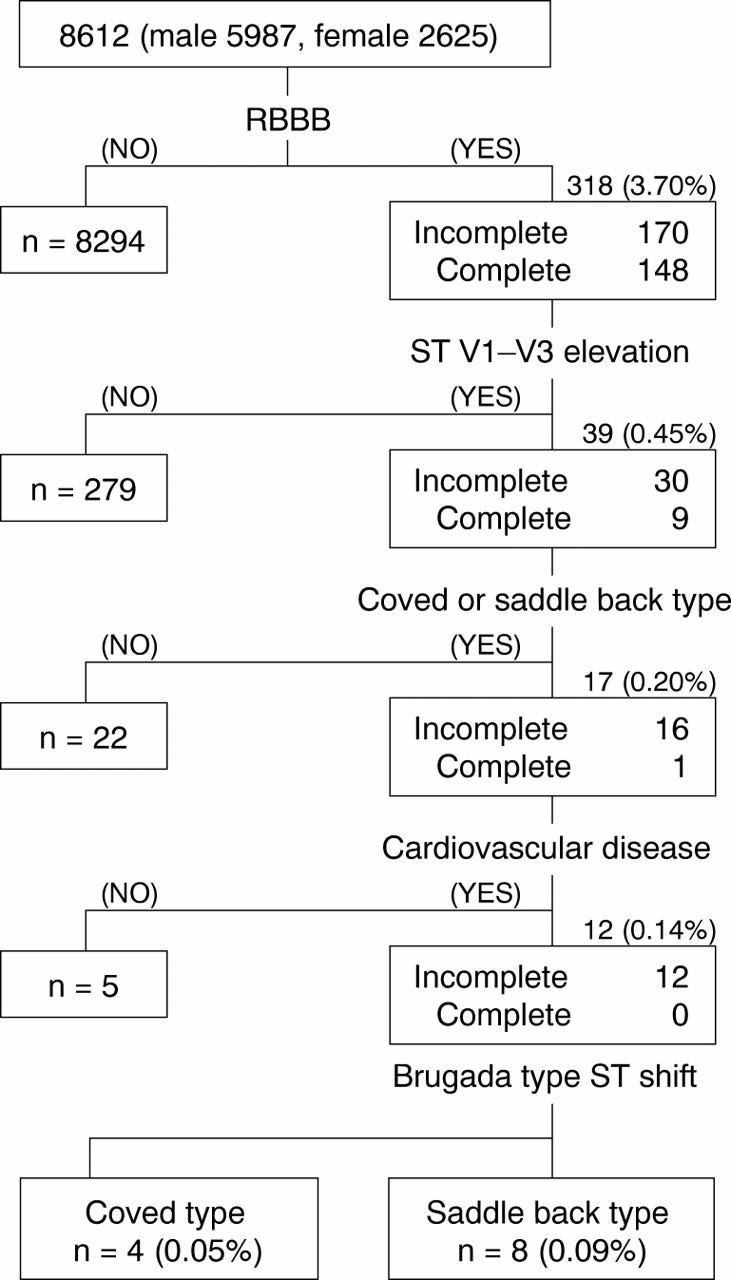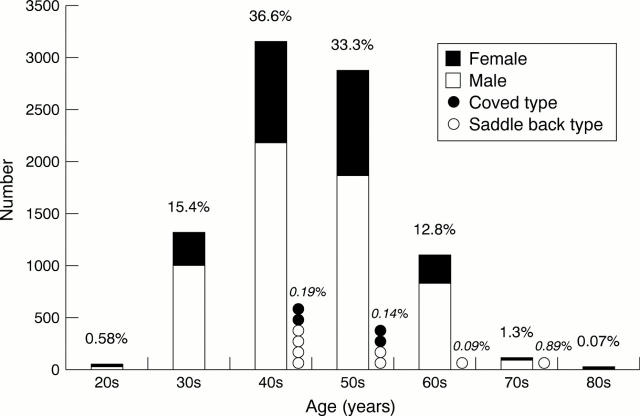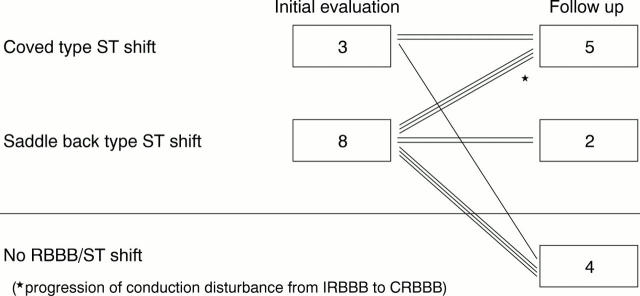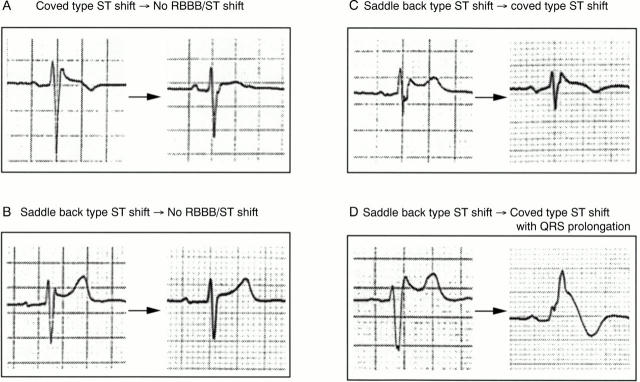Abstract
OBJECTIVE—To examine the modality and morbidity of asymptomatic ST segment elevation in leads V1 to V3 with right bundle branch block (Brugada-type ST shift). METHODS—8612 Japanese subjects (5987 men and 2625 women, mean age 49.2 years) who underwent a health check up in 1997 were investigated. Those with Brugada-type ST shift underwent the following further examinations over a two year period after the initial check up: ECG, echocardiogram, 24 hour Holter monitoring, treadmill exercise testing, signal averaged ECG, and slow kinetic sodium channel blocker loading test (cibenzoline, 1.4 mg/kg). RESULTS—Asymptomatic Brugada-type ST shift was found in 12 of 8612 (0.14%) subjects. Eleven of these 12 subjects were followed up. Follow up ECG exhibited persistent Brugada-type ST shift in seven of 11 (63.6%) subjects. ST shift was transformed from a saddle back to a coved type in three subjects. None of the subjects had morphological abnormalities or abnormal tachyarrhythmias. Positive late potentials were found in seven of 11 (63.6%) subjects. Augmentation of ST shift was shown by both submaximal exercise and drug administration in one of the 11 subjects (9.1%). CONCLUSIONS—Asymptomatic subjects with Brugada-type ST shift were not unusual, at a rate of 0.14% in the general Japanese population. Almost all of the subjects had some abnormalities in non-invasive secondary examinations. Additional and prospective studies are needed to confirm the clinical significance and the prognosis of asymptomatic Brugada-type ST shift. Keywords: Brugada syndrome; signal averaged electrocardiogram; sodium channel blocker; sudden death
Full Text
The Full Text of this article is available as a PDF (151.0 KB).
Figure 1 .
Bar graph showing age distribution of 8612 Japanese subjects in this study. Open and closed bars represent the male and female population in each generation, respectively. The number at the top of each bar is the percentage of the total population. Open and closed circles represent the subjects with saddle back and coved type ST shift, respectively. The number at the top of each circle is the percentage of the population by generation.
Figure 2 .

Diagnostic flow chart of Brugada-type ST shift in 8612 Japanese subjects. Values are the number (the percentage of the total population). RBBB; right bundle branch block.
Figure 3 .
Serial transformation of Brugada-type ST shift in follow up ECG. Persistent ST shift was confirmed in seven (63.6%) of 11 subjects followed up. However, Brugada-type ST shift changed from the saddle back type into the coved type in three subjects.
Figure 4 .
Representative cases of serial transformation. (A) Transformation of the coved type to no Brugada-type ST shift without right bundle branch block. (B) Transformation of the saddle back type to no Brugada-type ST shift without right bundle branch block. Transformation of the saddle back type to the coved type. (D) Transformation of the saddle back type to the coved type with prolonged QRS duration.
Selected References
These references are in PubMed. This may not be the complete list of references from this article.
- Alings M., Wilde A. "Brugada" syndrome: clinical data and suggested pathophysiological mechanism. Circulation. 1999 Feb 9;99(5):666–673. doi: 10.1161/01.cir.99.5.666. [DOI] [PubMed] [Google Scholar]
- Antzelevitch C. The Brugada syndrome. J Cardiovasc Electrophysiol. 1998 May;9(5):513–516. doi: 10.1111/j.1540-8167.1998.tb01844.x. [DOI] [PubMed] [Google Scholar]
- Atarashi H., Ogawa S., Harumi K., Hayakawa H., Sugimoto T., Okada R., Murayama M., Toyama J. Characteristics of patients with right bundle branch block and ST-segment elevation in right precordial leads. Idiopathic Ventricular Fibrillation Investigators. Am J Cardiol. 1996 Sep 1;78(5):581–583. doi: 10.1016/s0002-9149(96)00360-8. [DOI] [PubMed] [Google Scholar]
- Brugada J., Brugada P. Further characterization of the syndrome of right bundle branch block, ST segment elevation, and sudden cardiac death. J Cardiovasc Electrophysiol. 1997 Mar;8(3):325–331. doi: 10.1111/j.1540-8167.1997.tb00796.x. [DOI] [PubMed] [Google Scholar]
- Brugada J., Brugada R., Brugada P. Right bundle-branch block and ST-segment elevation in leads V1 through V3: a marker for sudden death in patients without demonstrable structural heart disease. Circulation. 1998 Feb 10;97(5):457–460. doi: 10.1161/01.cir.97.5.457. [DOI] [PubMed] [Google Scholar]
- Brugada P., Brugada J. Right bundle branch block, persistent ST segment elevation and sudden cardiac death: a distinct clinical and electrocardiographic syndrome. A multicenter report. J Am Coll Cardiol. 1992 Nov 15;20(6):1391–1396. doi: 10.1016/0735-1097(92)90253-j. [DOI] [PubMed] [Google Scholar]
- Brugada R., Brugada J., Antzelevitch C., Kirsch G. E., Potenza D., Towbin J. A., Brugada P. Sodium channel blockers identify risk for sudden death in patients with ST-segment elevation and right bundle branch block but structurally normal hearts. Circulation. 2000 Feb 8;101(5):510–515. doi: 10.1161/01.cir.101.5.510. [DOI] [PubMed] [Google Scholar]
- Corrado D., Nava A., Buja G., Martini B., Fasoli G., Oselladore L., Turrini P., Thiene G. Familial cardiomyopathy underlies syndrome of right bundle branch block, ST segment elevation and sudden death. J Am Coll Cardiol. 1996 Feb;27(2):443–448. doi: 10.1016/0735-1097(95)00485-8. [DOI] [PubMed] [Google Scholar]
- Fujiki A., Usui M., Nagasawa H., Mizumaki K., Hayashi H., Inoue H. ST segment elevation in the right precordial leads induced with class IC antiarrhythmic drugs: insight into the mechanism of Brugada syndrome. J Cardiovasc Electrophysiol. 1999 Feb;10(2):214–218. doi: 10.1111/j.1540-8167.1999.tb00662.x. [DOI] [PubMed] [Google Scholar]
- Gussak I., Bjerregaard P., Egan T. M., Chaitman B. R. ECG phenomenon called the J wave. History, pathophysiology, and clinical significance. J Electrocardiol. 1995 Jan;28(1):49–58. doi: 10.1016/s0022-0736(05)80007-x. [DOI] [PubMed] [Google Scholar]
- Hurst J. W. Naming of the waves in the ECG, with a brief account of their genesis. Circulation. 1998 Nov 3;98(18):1937–1942. doi: 10.1161/01.cir.98.18.1937. [DOI] [PubMed] [Google Scholar]
- Kasanuki H., Ohnishi S., Ohtuka M., Matsuda N., Nirei T., Isogai R., Shoda M., Toyoshima Y., Hosoda S. Idiopathic ventricular fibrillation induced with vagal activity in patients without obvious heart disease. Circulation. 1997 May 6;95(9):2277–2285. doi: 10.1161/01.cir.95.9.2277. [DOI] [PubMed] [Google Scholar]
- Manolis A. S., Chiladakis J. A., Malakos J. S., Vassilikos V., Maounis T., Cokkinos D. V. Abnormal signal-averaged electrocardiograms in patients with incomplete right bundle-branch block. Clin Cardiol. 1997 Jan;20(1):17–22. doi: 10.1002/clc.4960200106. [DOI] [PMC free article] [PubMed] [Google Scholar]
- Martini B., Nava A., Thiene G., Buja G. F., Canciani B., Scognamiglio R., Daliento L., Dalla Volta S. Ventricular fibrillation without apparent heart disease: description of six cases. Am Heart J. 1989 Dec;118(6):1203–1209. doi: 10.1016/0002-8703(89)90011-2. [DOI] [PubMed] [Google Scholar]
- Matsuo K., Shimizu W., Kurita T., Inagaki M., Aihara N., Kamakura S. Dynamic changes of 12-lead electrocardiograms in a patient with Brugada syndrome. J Cardiovasc Electrophysiol. 1998 May;9(5):508–512. doi: 10.1111/j.1540-8167.1998.tb01843.x. [DOI] [PubMed] [Google Scholar]
- Miyazaki T., Mitamura H., Miyoshi S., Soejima K., Aizawa Y., Ogawa S. Autonomic and antiarrhythmic drug modulation of ST segment elevation in patients with Brugada syndrome. J Am Coll Cardiol. 1996 Apr;27(5):1061–1070. doi: 10.1016/0735-1097(95)00613-3. [DOI] [PubMed] [Google Scholar]
- Nademanee K., Veerakul G., Nimmannit S., Chaowakul V., Bhuripanyo K., Likittanasombat K., Tunsanga K., Kuasirikul S., Malasit P., Tansupasawadikul S. Arrhythmogenic marker for the sudden unexplained death syndrome in Thai men. Circulation. 1997 Oct 21;96(8):2595–2600. doi: 10.1161/01.cir.96.8.2595. [DOI] [PubMed] [Google Scholar]
- Tada H., Aihara N., Ohe T., Yutani C., Hamada S., Miyanuma H., Takamiya M., Kamakura S. Arrhythmogenic right ventricular cardiomyopathy underlies syndrome of right bundle branch block, ST-segment elevation, and sudden death. Am J Cardiol. 1998 Feb 15;81(4):519–522. doi: 10.1016/s0002-9149(97)00942-9. [DOI] [PubMed] [Google Scholar]
- Toyofuku M., Takaki H., Sunagawa K., Kurita T., Shimizu W., Suyama K., Aihara N., Kamakura S. Exercise-induced ST elevation in patients with arrhythmogenic right ventricular dysplasia. J Electrocardiol. 1999 Jan;32(1):1–5. doi: 10.1016/s0022-0736(99)90015-8. [DOI] [PubMed] [Google Scholar]
- Viskin S., Belhassen B. Polymorphic ventricular tachyarrhythmias in the absence of organic heart disease: classification, differential diagnosis, and implications for therapy. Prog Cardiovasc Dis. 1998 Jul-Aug;41(1):17–34. doi: 10.1016/s0033-0620(98)80020-0. [DOI] [PubMed] [Google Scholar]
- Viskin S., Fish R., Eldar M., Zeltser D., Lesh M. D., Glick A., Belhassen B. Prevalence of the Brugada sign in idiopathic ventricular fibrillation and healthy controls. Heart. 2000 Jul;84(1):31–36. doi: 10.1136/heart.84.1.31. [DOI] [PMC free article] [PubMed] [Google Scholar]





